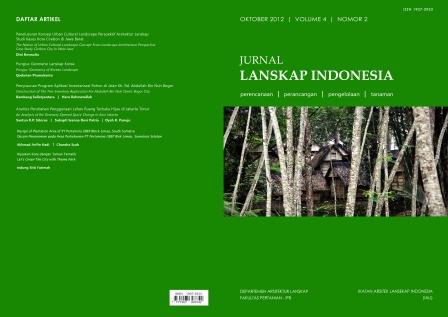The Notion of Urban Cultural Landscape Concept From Landscape Architecture Perspective
Abstract
Urban cultural landscape is a concept considered as new and still raises many arguments among scholars. This concept comes from terms of cultural landscape and first was revealed in 1925 by Sauer, a Geographer. Then this term has evolved to be a concept of urban cultural landscape after finding many countries in the world are interesting to propose their historic cities as a World Heritage Cultural Landscape. Currently, some researchers from geography, anthropolo-gy, economics, architecture and landscape architecture have tried to reveal the concept. However, generally the description of their concept is more in processing or exploring the establishment elements of urban cultural landscape, so as can be seen that the concept is not comprehensive yet and still partial in accordance with the scientific background. Therefore, this paper aims to reveal the concept of urban cultural landscape from different disci-plines to gain a comprehensive one. And to support the establishment of the concept, the paper uses a case study, which is Cirebon city as it is one of the unique and historic cities in Indonesia. The city has been established since 15th century. The establishment has been affected by social, cultural, political and economic impacts from various periods of rules (Sultanate Cerbon, Dutch Colonial and the Republic of Indonesia).of rule (Sultanate Cerbon, Dutch Colonial and the Republic of Indonesia). Keywords: Cirebon city, landscape elements, urban componentsDownloads
This journal permits and encourages authors to post items submitted to the journal on personal websites or institutional repositories both prior to and after publication, while providing bibliographic details that credit, if applicable, its publication in this journal. However, after the article is submitted and published in this journal, it is fully copyrighted by the Jurnal Lanskap Indonesia or JLI. If excerpts from other copyrighted works are included, the author must obtain written permission from the copyright owner and give credit to the source in the article. Then, the writer or reader is allowed to copy, share, and redistribute articles/material in any form. But it must still include the appropriate source and credit because the article in this journal is licensed by Creative Commons Attribution 4.0 International License (CC BY 4.0).
I. Proposed Policy for Journals That Offer Open Access
Authors who publish with this journal agree to the following terms:
- Authors retain copyright and grant the journal right of first publication with the work simultaneously licensed under a Creative Commons Attribution License that allows others to share the work with an acknowledgement of the work's authorship and initial publication in this journal.
- Authors are able to enter into separate, additional contractual arrangements for the non-exclusive distribution of the journal's published version of the work (e.g., post it to an institutional repository or publish it in a book), with an acknowledgement of its initial publication in this journal.
- Authors are permitted and encouraged to post their work online (e.g., in institutional repositories or on their website) prior to and during the submission process, as it can lead to productive exchanges, as well as earlier and greater citation of published work (See The Effect of Open Access).
II. Proposed Policy for Journals That Offer Delayed Open Access
Authors who publish with this journal agree to the following terms:
- Authors retain copyright and grant the journal right of first publication, with the work after publication simultaneously licensed under a Creative Commons Attribution License that allows others to share the work with an acknowledgement of the work's authorship and initial publication in this journal.
- Authors are able to enter into separate, additional contractual arrangements for the non-exclusive distribution of the journal's published version of the work (e.g., post it to an institutional repository or publish it in a book), with an acknowledgement of its initial publication in this journal.
- Authors are permitted and encouraged to post their work online (e.g., in institutional repositories or on their website) prior to and during the submission process, as it can lead to productive exchanges, as well as earlier and greater citation of published work (See The Effect of Open Access).



























